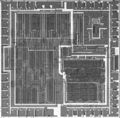Difference between revisions of "RP2A03"
| Line 6: | Line 6: | ||
}} | }} | ||
| − | The '''''RP2A03''''' is the CPU of the Famicom and [[Nintendo Entertainment System]] developed in two versions | + | The '''''RP2A03''''' is the CPU of the Famicom and [[Nintendo Entertainment System]] developed in two versions; the NTSC version is designated as RP2A03 or 2A03, while PAL version is designated as RP2A07 or 2A07. The only difference is the NTSC chip has a clock speed of 60 Hz, while the PAL chip has a clock speed of 50 Hz. |
The RP2A03 is an integrated 8 bit CPU developed for [[Nintendo]] by circuits manufacturer [[Ricoh]]. The microprocessor integrates a custom [[MOS Technology]] 6052 processor clocked at 60 Hz, rudimentary DMA, and most important to this site, a built in programmable sound generator (PSG) which developers used to make music. | The RP2A03 is an integrated 8 bit CPU developed for [[Nintendo]] by circuits manufacturer [[Ricoh]]. The microprocessor integrates a custom [[MOS Technology]] 6052 processor clocked at 60 Hz, rudimentary DMA, and most important to this site, a built in programmable sound generator (PSG) which developers used to make music. | ||
| + | Over the various versions of the Famicom and NES consoles, the chip has been revised multiple times. The latest appears to be the H revision found in the later versions of the top-loader model NES. | ||
| + | |||
| + | |||
| + | ==PSG== | ||
The PSG was designed by Nintendo engineer [[Yukio Kaneoka]], who also composed music and sound effects for numerous games. The chip is US patent publication number US4783812 A, application number 06/893,341, it was filed on 1986-08-05, and published on 1988-11-08, though it was patented in Japan around 1983. | The PSG was designed by Nintendo engineer [[Yukio Kaneoka]], who also composed music and sound effects for numerous games. The chip is US patent publication number US4783812 A, application number 06/893,341, it was filed on 1986-08-05, and published on 1988-11-08, though it was patented in Japan around 1983. | ||
Revision as of 13:32, 22 November 2013
| RP2A03 | |
 |
|
| Developer: | Ricoh |
| Released: | 1983 |
| Type: | [[:Category:{{{Type}}}|{{{Type}}}]] |
The RP2A03 is the CPU of the Famicom and Nintendo Entertainment System developed in two versions; the NTSC version is designated as RP2A03 or 2A03, while PAL version is designated as RP2A07 or 2A07. The only difference is the NTSC chip has a clock speed of 60 Hz, while the PAL chip has a clock speed of 50 Hz.
The RP2A03 is an integrated 8 bit CPU developed for Nintendo by circuits manufacturer Ricoh. The microprocessor integrates a custom MOS Technology 6052 processor clocked at 60 Hz, rudimentary DMA, and most important to this site, a built in programmable sound generator (PSG) which developers used to make music.
Over the various versions of the Famicom and NES consoles, the chip has been revised multiple times. The latest appears to be the H revision found in the later versions of the top-loader model NES.
Contents
PSG
The PSG was designed by Nintendo engineer Yukio Kaneoka, who also composed music and sound effects for numerous games. The chip is US patent publication number US4783812 A, application number 06/893,341, it was filed on 1986-08-05, and published on 1988-11-08, though it was patented in Japan around 1983.
The PSG allowed two square wave channels with four different pulses; 12.5%, 25%, 50%, 75%. The 25% and 75% wave sound so identical it's hard to tell which is which. The third channel was a triangle wave which was usually used for bass, but was also used for flutey sounds or percussion. The fourth channel was a noise channel that had two different modes; white noise and pink noise. The fifth channel was the DPCM (Delta Pulse Code Modulation) which allowed a 7-bit sample. While the DPCM was mainly used for drum sounds, it was also used for voices, waveforms, and other sound effects.
RP2A07
PAL versions of Nintendo Entertainment System use the RP2A07. It is identical to the 50 Hz RP2A03, only it's clocked at 60 Hz to match the PAL television refresh rate. This slower clock rate results in the music playing a half-step lower and a little slower than the 2A03. Audio programmers were expected conform to this change in speed by altering their music slightly, but many just left the music slower.
Picture Gallery
Links
- en.wikipedia.org/wiki/Ricoh_2A03 - Wikipedia.
- nesdev.com/2A03%20technical%20reference.txt - Programmers technical reference.
- google.com/patents/US4783812 - US patent information.
- famitracker.com/wiki/index.php?title=2A03 - Nintendo sound chips.











